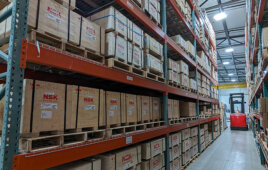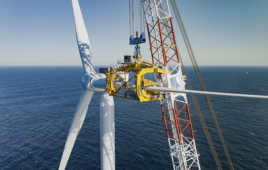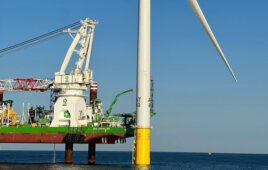Frank May / service engineer / GlobeCore GmbH
The last 20 years have seen strong growth in both the number of wind farms and the amount of power generated by wind. This growth is a logical consequence of the increasing demand for electricity and the need to diversify energy sources and reduce harmful emissions. The growth, however, would not have been possible without ongoing enhancements to equipment design, as well as the increase of wind turbine size and power outputs and improved maintenance to key turbine components, such as the gearbox.
Common gearbox problems
There are several essential gearboxes in a turbine: the main gearbox, as well as yaw-drive gearboxes that position the nacelle relative to the wind direction and pitch drives that adjust the blade angle of attack. The main gearbox is designed to speed the slow, high-torque rotation into a much faster rotation for the generator.
Factors that may adversely affect the drivetrain gearbox include variations in wind speed and direction, temperature, vibration, and the ingress of moisture. These factors make the gearbox a vulnerable component of the turbine’s drivetrain.
Common problems that occur in gearboxes include scuffing and microppitting, tooth-root breakage, and bearing failure. Micropitting is a starting point for a chain of destructive events, and if left unchecked, results in tooth breakage and the need to replace the gears. Aside from the constantly changing load, micropitting is also caused by insufficient lubricant film thickness, incorrect lubricant viscosity, and foaming.

GlobeCore offers CMM-G and CMM-GL units that drain and fill gearbox oil and clean the gearbox in wind turbines. These units facilitate quick servicing and can be used with wind turbines made by various manufacturers.
The cost of gearbox maintenance and replacement, along with the costs associated with the inevitable downtime, are a significant part of wind turbine operation losses. The condition of gearbox oil in the wind turbine is an important factor in saving on these costs.
Gearbox oil explained
The main purpose of gearbox oil is to reduce friction. However, it also keeps the gearbox clean and protects the metal surfaces from corrosion. The better the oil, the more reliable the gearbox.
Gearboxes can be filled with synthetic or mineral gearbox oil with anti-scuffing additives. A lubricant is selected based on such factors as viscosity, viscosity index, pour point, additives, and cost.
Synthetic oils have a lower pour point than mineral oils, which let the gearbox operate more efficiently in colder ambient temperatures. Synthetic oil also has higher a viscosity index; its viscosity changes less with temperature compared with that of mineral oil. A modest advantage of mineral oil is its lower price tag.
Gearbox oil deterioration is associated with oxidation due to heat, contamination, and additive exhaustion. Water is the most troublesome of the contaminants. While particulate matter and sludge may be filtered out, it is difficult to remove water from the gearbox without a complete oil change.
For most wind turbine gearbox oils, the critical concentration of water is less than 500 ppm. When water content exceeds this limit, the lubricant degrades with additive sedimentation. Water also causes film breakdown, oil oxidation, and corrosion. Recommended purity of wind turbine gearbox oil is at least 16/14/11, according to ISO 4406.
When to change the gearbox oil
The oil filter in the gearbox should be changed after the first 500 hours of operation. After one year of operation, an oil sample should be taken to determine its viscosity, water content, acid number, contamination with particulate matter, and additive exhaustion. After two years, some recommend a complete oil change, even if its quality approximates the standards.
Periodically analyzing the oil and determining a change schedule based on the analyzed parameters may point to oil changes less than once every two years. It should be noted, however, that using oil with the quality even similar to the standards may still cause failures and damage the gearbox.
Another option involves using a “lifetime” oil that has service life equal to the service life of the gearbox. However, the field of application of such oil is currently limited to small gearboxes. In most cases, repairing small gearboxes is not viable (the cost of repairs is roughly comparable to the cost of a new gearbox), so the whole gearbox is changed along with the oil. Large gearboxes, on the other hand, require oil change and servicing in the course of operation.
Manually changing the oil is a difficult and time-consuming task. Workers lift and lower oil in special canisters using lifting devices (elevators or ladders). This would commonly require a team of three or four and about eight hours of work time.
Time and labor costs can be reduced by using special oil-change equipment that facilitates quick servicing with integrated oil containment and transportation tanks; an oil heater to reduce viscosity and speed oil pumping; gearbox cleaning with special flushing oil; and mitigation of oil spills and contact between the oil and the environment.
About the author
Frank May is a service engineer at GlobeCore GmbH (Oldenburg, Germany). May has 30 years of practical experience in commissioning and servicing various oil-immersed and oil-processing equipment. He can be reached at energie@globecore.de.
Filed Under: Components, Gearboxes, Lubricants, News, O&M





